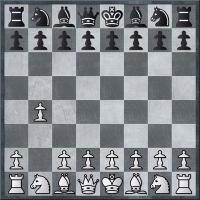So, you are sitting down at your chess board across from someone in a tournament. Your white, he's black. You play 1. e4. This is the most popular move for white. You have been practicing for weeks looking at all the different strategies and opening lines black can play against it. You expect your opponent to play c5 or e5. Your opponent looks at the board, and plays the mind blowing move 1...g5. He looks at you calmly, waiting for your reply.
Unorthodox Openings, categorized under the A00 and B00 sections of the ECO codes, are peculiar first moves that can make you ask if your opponent is either out of his mind or a very good chess player to risk such a dubious move. Although they are rarely played at high level chess and tournaments, they are occasionally played as a secret weapon to take line-memorizers down, or just set up an unclear position. Today, I will explain the Polish, otherwise known as the Sokolsky or the Orangatang.
The idea of the Polish is to gain queen side space and fianchetto the dark squared bishop to the a1-h8 diagonal. White will than play e3, Nf3, and c4 for center control.
Here is one game I played using the Polish. It was in a tournament game.
After the game, my opponent admitted he had never seen the opening before and did not know how to play against it.
The major risk that white is taking while playing this opening is he is neglecting the center on his first move. Black should take advantage of this by playing 1...e5 or 1...d5. After 2.Bb2, it does not look like black can advance his other center pawn to the center of the board without taking on weaknesses. In fact, black can take control of all the center.
Here, black is taking full advantage of white's neglect for the center. This is better for black; however, white will still follow up with the same plans of e3 and c4. White may also try Nf3 and d4 hoping to break down black's powerful center.
Here is another game I played in the same tournament. My opponent did not know about 2...Qd6, but that does not mean he did not put up a good fight.
Black created a very solid position with his pawns and bishop in this game. My opponent had created this setup on previous games against different openings (such as 1.d4), and I am sure he felt this was a good and comfortable setup for him psychologically.
Here is the third and final game I will show in which I played the Polish.
You may notice that in both my first and third game, I brought the b1 knight all the way around to g3. You see this same maneuver in the Ruy Lopez in hopes for an attack on the king side. As I have said before, the Polish is and opening based on the queen side. Why would I attack the king side? This rerouting of the b1 knight is something I adapted to the 1...e5 variation of the Polish. I found that the pressure the queen and dark squared bishop gave on the king side from a distance could turn into an attack without a pawn on e4. This is against the pawn pointing theory of International Master Jerem
y Silman. The pawn pointing theory of chess is to play on the side of the board that your pawns point.
In this example, white's pawns point to the king side, so he should play on the king side. Black's pawns point to the queen side, so he should play on the queen side.
In the 1...e5 variation of the Polish Opening, even though I should play on the queen side, I occasionally can have a king side attack. This usually happens if I get a knight on f5 and I have my bishop and queen pointing at the pawns on the castled king. This is not enough, and the center should be somewhat open for a rook or two.
In the 1...d5 variation of the Polish, white usually fianchettos the light squared bishop as well, either with g3 and Bg2 or the bishop moving to e2 and f3.
And this concludes my overview of the Polish Opening.

